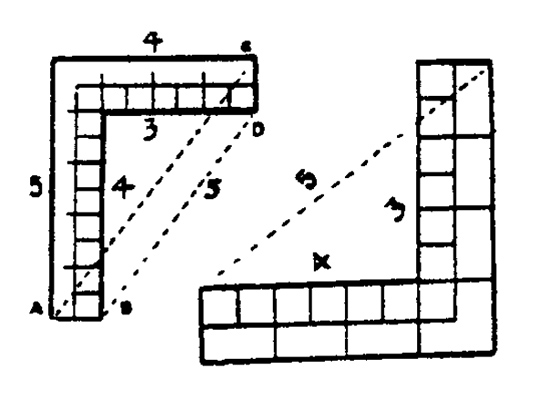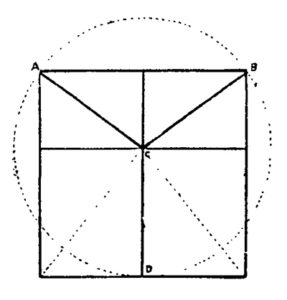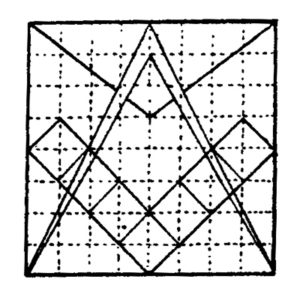Most of the Masonic eloquence that one hears into which are introduced references to the working tools of the “sublime degree” being wound around their purely spiritual associations, as conceived by the speakers, it is altogether lost sight of that there are practical reasons for the selection of these figures as chief among all symbols of a mystic order, descended from the wisdom religion of the distant past. Much can be perceived from an examination of these figures with reference to their relation one to another.

There are two squares known to Freemasonry. One is the speculative and the other is the operative Mason’s square.
The operative Mason’s square is the true square of Freemasonry and is far more often employed in Masonic symbolism of a bygone age than the other. There are important reasons for this fact. The basic arithmetical quantities of the geometry of self-existent proportions found in nature are the numbers 3, 4, and 5, which, in their simplest combination, constitute the wonderful triangle of our ancient brother Pythagoras.
Read: The Mystical Meaning of So Mote It Be
That which we call an operative Mason’s square is as completely natural a figure as the triangle in question, because in addition to its definition of the angle of 90 degrees, the fourth part of a circle, it also lays out the two most important oblongs, those of 3 by 4 and 4 by 5, the angles of which are defined by the dotted lines b-d and a-c. From myriad applications of these simple figures arose all the sacred proportions employed in planning the tabernacles and Temples of the ancient world.

Our apron is actually an ancient Egyptian geometrical problem, based on ‘the principles of the operative Mason’s square, showing a quick and almost perfect manner of determining a squared circle, in which the peripheries of both square and circle are of precisely equal length. Correctly dissected, it consists of two oblongs of 3 by 4 (at the top) and two oblongs of 4 by 5 (at bottom) . These constitute a perfect square. Setting the immovable point of the compasses upon the intersection of the two lines that divide the square and the free point upon a or b, we trace a circle the circumference of which is equal to that of the square.
It is not difficult to see that the dimensions of the completed square are 8 by S, those of the age-old chess or draft board, which we find represented as the game of kings and queens on the oldest Egyptian monuments. Taking the

point c, the center of the circle, as the situation of the Sun in the center of our universe, and that, as our ancient brethren viewed it, the physical vesture of the Great Architect, JEHOVAH, we can see the application in both square and compasses, and the clothing of a Master Mason in the fact that the triangle e-c-f is the vertical section of the mighty Pyramid of Cheops, erected to perpetuate this self-same design at the remote period of 2170 B . C. The altitude c-d is of 10 parts or Jod, to a base of the same measure, or Ha, Vv, Ha, (5 plus 6 plus 5) constituting the mysterious Tau cross of the ancient Israelites.’ The derivation of the speculative square also becomes plain.
It has been the writer’s privilege to discover the vestiges of the original Magian cult of the Great Architect, or “Builder of the Universe,” among the Bactrian’s of northern India (now called Bokhara) conquered and settled among by Greeks, accompanying Alexander the Great of Macedon.
Contents – The Beginning of Masonry
Previous – The Lodge on High
Next – The Symbolic Trowel
